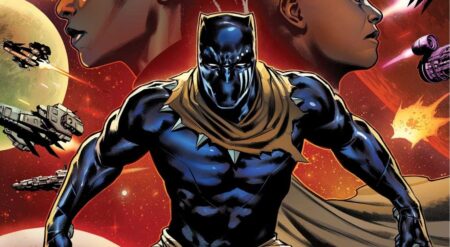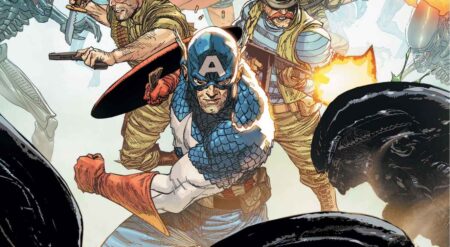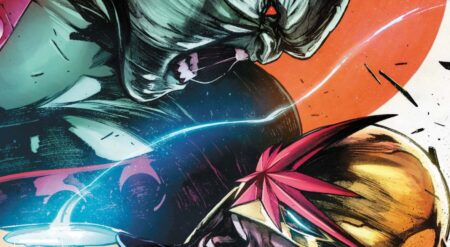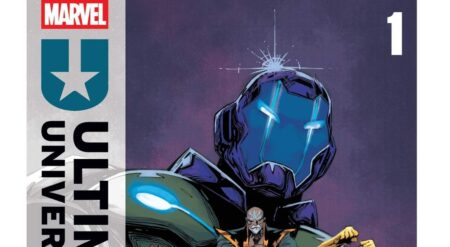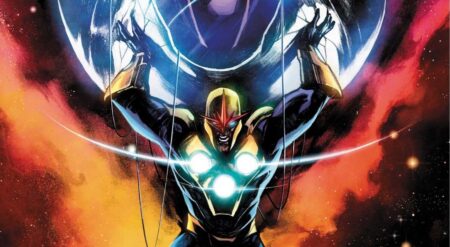Avengers #10 is published by Marvel Comics, written by Jed MacKay, art by C.F. Villa, colors by Federico Blee and letters by Cory Petit. With the Avengers distracted, Kang is vulnerable to attack.
This issue ends the next Tribulation Event in a very different method. The conclusion to this one isn’t a real win, with the villains moving through an opening and robbing the heroes of their advantage. The chapter is the opposite of the previous one. Where Avengers #9 was all action, this issue focuses on exposition and manipulation. It details that there is much more lore to MacKary’s Avengers run. The reasons for the involvement of all of the villains become clearer and deepen the storylines.
The book slows the pace down to make way for an enticing story. What looks like a villain for a single arc actually bears the potential for something larger. Avengers #10 splits in two, tying up loose ends. The early issues of this arc involving Nightmare suddenly become more than just a distraction, becoming integral. So much of the book is surprising with revelations about the future of the series.
The blending between characters, old and new, is superb. Villains have a particular emphasis placed on them throughout the comic. Myrddin and the Twilight Court attack Kang. Just coming out of a coma, the time traveler is helpless to resist the interrogation and taunting from the mysterious magician. Kang always runs his own route and works for his own gain. His reaction to what happens to him is fascinating due to his feeling humiliated. He appears defenseless, and that hurts more than the pain of the attack itself.
On a different plane of existence is Nightmare. He approaches the Avengers with an arrogance stemming from being the lord of his realm. Scarlet Witch and Thor, possibly the most powerful members of the team, visit him. And like Kang, Nightmare’s power suddenly looks dwindled. The presence of the new villain seems to be unsettling the old guard. Myrddin’s power is slowly growing despite not providing many examples of it, established by using two foes that are usually big bads in Avengers stories. And the Avengers’ strength is setting up a clash of the ages.
The art reverts to normal as Villa returns to the book after taking an issue off. Avengers #10 has much less movement and yet Villa keeps it interesting. Kang’s torment gives way to panic as his attempts to get up are repeatedly met by an intense resistance. The faceless visage of Myrddin haunts, hiding any intentions or emotions. Then comes Nightmare. We take in his progressive descent into discomfort and unease, fantastically depicted over time. Issues such as these depict the artist’s storytelling ability better than one filled with action, as the smallest of details can affect everything.
The colors are excellent. In Kang’s recovery room, there are no costumes or extravagance. Because of that, the room is bleak and beige. Myrddin adds color to the story with a bright red cloak. The glimpses of the fight still happening in the rest of the Impossible City are used as a brief display of action, and that is where the most variety is visible. Within the dark green of Nightmare’s realm, the red of Scarlet Witch and Thor becomes much more dominant and powerful. The lettering is very clear and dynamic, which is vital in dialogue-heavy issues like this one.
Avengers #10 steps up the storytelling. Drawn in through the action, this issue takes the time to draw the Avengers deeper into a war that appears to cross points in time and dimensions. The villains have spooked both Kang and Nightmare, which means their danger is even greater than initially realized. The power of this team, which may be greater than any other Avengers roster, has transcended their regular enemies and requires something new.
Avengers #10 is available where comics are sold.
Avengers #10
TL;DR
Avengers #10 steps up the storytelling. Drawn in through the action, this issue takes the time to draw the Avengers deeper into a war that appears to cross points in time and dimensions. The villains have spooked both Kang and Nightmare, which means their danger is even greater than initially realized.



